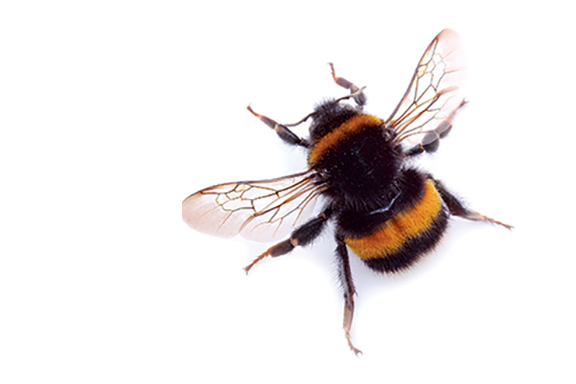Bumblebees!
By Abigail Duman
It was a bright, sunny day as Ranger Brooke spotted Lily walking along the path toward town. “Hi, Lily,” Ranger Brooke called. “You on your way to the library?”
“Yep,” Lily replied. “My mom and Luke are already there.” Under her breath, she muttered, “I hope Luke doesn’t beat me to all the good books.”
Ranger Brooke smiled. “Nah, there’s a whole library full of books! How’d you fall behind your mom and brother?”
“I was starving!” said Lily. “I had to stop at the café for a sandwich.”
“Oh yeah? What kind?” asked Ranger Brooke, just as a faint buzzing sound filled the air.
“Cheese and tomato,” Lily said. “It was delicious!”
“I might have to stop by there . . .” Ranger Brooke began, but Lily suddenly let out a shriek.
“Eeeek! Something’s in my hair—please get it out, get it out!”
“Lily, just hold still a moment while I look!” said Ranger Brooke calmly.
“Please hurry, Ranger Brooke!” Lily begged as the buzzing grew louder.
“OK, I see what it is—it’s a bumblebee,” Ranger Brooke said, watching it lift off. “There it goes!” The buzzing faded into the distance.
“Uggghhhh!” Lily groaned. “I can’t stand those bumbling, buzzing bees.”
“You might like them better if you knew more about them,” said Ranger Brooke.
“I know quite a lot about them already,” Lily argued. “They pollinate flowers and get lost in my hair. Oh, and they can sting only once.”
“That’s not quite right,” Ranger Brooke said gently.
“It isn’t?” Lily asked.
“Bumblebees do pollinate flowers,” Ranger Brooke explained. “They actually vibrate their wings against the flower, which encourages the release of pollen.”
“Oh, so their buzzing serves a purpose,” Lily said reluctantly. “Cool. . . I guess.”
“Yes,” said Ranger Brooke. “ ‘Buzz’ pollination is especially effective for certain plants, like tomatoes.”
“So I guess bees are good for tomatoes anyway,” Lily admitted.
“And for you, too,” Ranger Brooke added. “You just had a tomato sandwich. And there aren’t many veggies you eat that weren’t pollinated by bees.”
“Fine,” Lily sighed, “but I guess I just wish that bees had a better sense of direction. My hair looks nothing like a flower!”
“Bumblebees are actually skilled navigators,” Ranger Brooke said. “They travel from flower to flower without a problem.”
“Huh?” Lily said, surprised.
“And,” continued Ranger Brooke, “bumblebees can combat colder temperatures because their ‘buzzing’—or shivering—warms their fuzzy bodies.”
“Interesting . . .” said Lily thoughtfully.
Ranger Brooke laughed. “If your bumblebee friend thinks that your hair is a flower, at least you won’t worry about another visitor!”
“Oh? Why not?” asked Lily. “They leave scents behind on the flowers that they pollinate,” explained Ranger Brooke. “This communicates to other bees that the flower has already been pollinated.”
“Great,” Lily said, rolling her eyes. “Now I have to go home and wash my hair.”
Ranger Brooke chuckled. “All of God’s creation is truly fascinating. So much thought and design went into the bumblebee!”
“You know what. . . you’re right, Ranger Brooke!” said Lily. “But what about stinging only once?”
“Bumblebees can actually sting more than once,” Ranger Brooke said. “Their stingers are smooth; they won’t die after stinging, as honeybees do.”
“Oh!” Lily exclaimed.
“Yes,” Ranger Brooke nodded. “So be respectful of bees.”
“I’m glad that bee didn’t sting me today!” said Lily.
“Me too! Lily, you and the bumblebee do have one thing in common,” Ranger Brooke teased.
“What’s that?” Lily asked.
“You both get really hungry! Bumblebees have a fast metabolism. In fact, on a full stomach, they are only about 40 minutes from starving.”
“Literally? That’s way hungrier than even me!” Lily said, laughing.
“Without God we can’t last very long without food, either,” Ranger Brooke said softly. “We depend on Him for life.”
“I feel a little hungry again now,” said Lily. “But I’m going to buzz back into the library now.”
“Any special book you’re looking for?” Ranger Brooke asked.
“There is now,” Lily said with a grin.
“Bumblebees!” Ranger Brooke laughed.
This story was originally written for Creation Nuggets, a Discovery Mountain program. It has been reformatted and used with permission. Abigail Duman is a freelance writer living in West Virginia with her husband and three boys.

